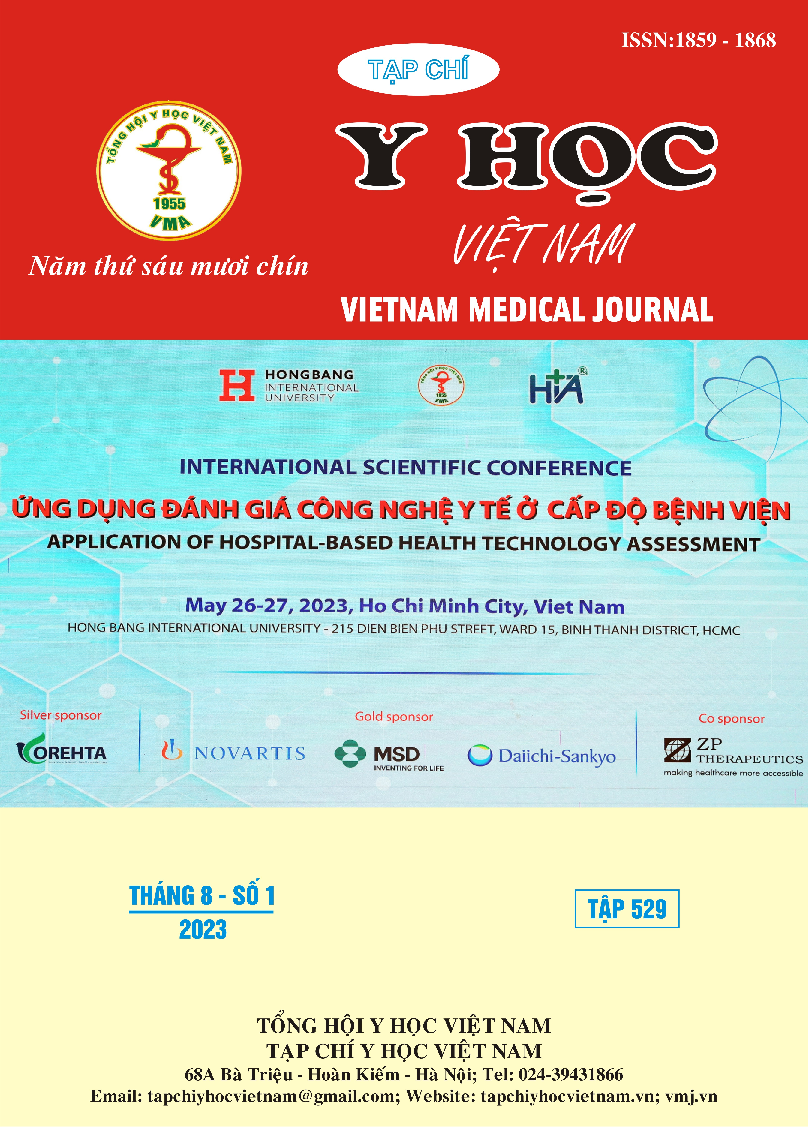KẾT CỤC THAI KỲ Ở NHỮNG THAI PHỤ VÀO CHUYỂN DẠ NHIỄM SARS-COV-2 TẠI BỆNH VIỆN TỪ DŨ
Nội dung chính của bài viết
Tóm tắt
Đặt vấn đề: Sự xuất hiện của virus mới Coronavirus 2 (SARS-CoV-2) vào tháng 12 năm 2019 (đại dịch COVID-19), đánh dấu một đại dịch lớn cho cả thế giới. Phụ nữ mang thai là đối tượng dễ có nguy cơ có kết cục xấu liên quan đến COVID-19 vì thế hiểu rõ điều này sẽ giúp cho việc đánh giá, theo dõi và can thiệp trên thai kỳ kịp thời và phù hợp. Mục tiêu: Mô tả đặc điểm thai phụ có xét nghiệm dương tính SARS-CoV-2 khi vào chuyển dạ, Phân tích đặc điểm kết cục thai kỳ chuyển dạ sinh có xét nghiệm dương tính với SARS-CoV-2 ở mẹ và con. Phương pháp: Nghiên cứu báo cáo loạt ca hồi cứu tất cả phụ nữ mang thai có xét nghiệm dương tính với xét nghiệm SARS-CoV-2 ngay trước khi chuyển dạ tại Bệnh viện Từ Dũ, trong thời gian từ 1/12/2021 đến 30/6/2022.Thu thập số liệu bằng phương pháp lấy mẫu toàn bộ từ hồ sơ bệnh án. Kết quả: Mức độ nhiễm SARS-CoV-2 nhẹ/ không triệu chứng chiếm 96.33%. Các triệu chứng phổ biến bao gồm: sốt (8%), ho (8.67%), đau họng ( 9%). Ghi nhận 59.33% vào chuyển dạ tự nhiên, 17.67% khởi phát chuyển dạ. Trong quá trình theo dõi chuyển dạ, 47.33% trường hợp được chỉ định mổ lấy thai, 52.67% được sinh ngả âm đạo. Kết cục xấu chung của mẹ và/hoặc con chiếm 15.6%(KTC 95%: 11.57-19.77). Trong đó, kết cục thai kỳ xấu ở mẹ chiếm 4% (KTC 95%: 1.8-6.2) và kết cục xấu ở con chiếm tỉ lệ 12.33% (KTC 95%: 8.63-16.03). Với tỷ lệ băng huyết sau sinh (2%), nhiễm trùng sau sinh (2%), sinh non (9%), nhẹ cân (5.33%), Apgar 1 phút < 7 điểm (6%). Kết luận: Kết cục thai kỳ nhiễm SARS-CoV-2 chiếm 15.6%, trong quá trình theo dõi chuyển dạ cần theo dõi sát, can thiệp phù hợp trên thai kỳ nhiễm SARS-CoV-2 để hạn chế được các kết cục bất lợi cho thai kỳ
Chi tiết bài viết
Từ khóa
SARS-CoV-2, COVID-19, kết cục thai kỳ, chuyển dạ.
Tài liệu tham khảo
2. M. Abedzadeh-Kalahroudi, M. Sehat, Z. Vahedpour, et al. (2021), "Maternal and neonatal outcomes of pregnant patients with COVID-19: A prospective cohort study", Int J Gynaecol Obstet, 153(3), pp. 449-456.
3. R. da Rosa Mesquita, L. C. Francelino Silva Junior, F. M. Santos Santana, et al. (2021), "Clinical manifestations of COVID-19 in the general population: systematic review", Wien Klin Wochenschr, 133(7-8), pp. 377-382.
4. G. Grgić, A. Cerovac, I. Hudić, et al. (2022), "Clinical Manifestation and Obstetric Outcomes in Pregnant Women with SARS-CoV-2 Infection at Delivery: A Retrospective Cohort Analysis", J Pers Med, 12(9).
5. T. A. Manuck, M. M. Rice, J. L. Bailit, et al. (2016), "Preterm neonatal morbidity and mortality by gestational age: a contemporary cohort", Am J Obstet Gynecol, 215(1), pp. 103.e101-103.e114.
6. M. Prabhu, K. Cagino, K. C. Matthews, et al. (2020), "Pregnancy and postpartum outcomes in a universally tested population for SARS-CoV-2 in New York City: a prospective cohort study", Bjog, 127(12), pp. 1548-1556.
7. F. Zhou, T. Yu, R. Du, et al. (2020), "Clinical course and risk factors for mortality of adult inpatients with COVID-19 in Wuhan, China: a retrospective cohort study", Lancet, 395(10229), pp. 1054-1062.
8. Tessa M. Wardlaw, Ann Klimas Blanc, Jelka Zupan, et al. (2004). Low birthweight: country regional and global estimates.


